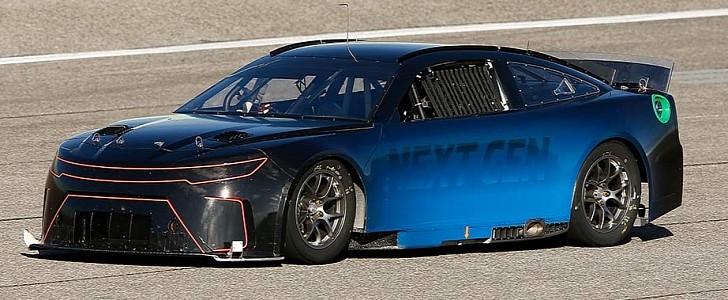If you happen to follow more than one car-themed meme page on your preferred social network, you might have seen humorous images comparing NASCAR to other forms of motorsport in the event of rain. Well, a part of those jokes will no longer make sense after next year, when NASCAR will allegedly introduce a wet weather package for the Next Gen cars.
The package is meant to solve rain delays at oval races, but it will not be used on all ovals. Instead, each Next-Gen NASCAR racer will get a windshield wiper, a set of rain lights, mud flaps (to diminish water spray), and adequate tires for rain, sources claim.
The 2023 wet weather package will feature four taillights, which will operate both as brake lights, and as constantly flashing marking lights to help visibility in heavy water spray conditions.
Currently, just one light flashes in the rain, but 2023 race cars will include two in the rear windscreen and two between the rear bumper and the diffuser. That is one more than what is usually on production vehicles.
Yet, we will not see the package in use on all race tracks but only on the short ovals chosen by the series' organizers. For example, the Martinsville Speedway in Virginia will have competitors race with the wet weather package and the Phoenix Raceway, as R&T notes.
Mind you, this package already existed for the Next-Gen cars, as it was used on road courses when they encountered rain.
Like in other forms of motorsport, this wet weather package is not the solution to any rain intensity, and it will only work if there is not too much standing water. However, it is better than nothing if you ask us. Maybe other ovals will be considered for this package once the series gets a taste of racing in the rain, but only if the track conditions allow it.
The main issue and the biggest risk is aquaplaning, which becomes a bigger risk at higher speeds, and ovals will bring the highest speeds in the series, so it is easy to comprehend why it may be a problem.
Even with the best tires ever, if you drive fast enough, and encounter more water than the remaining contact patch (it decreases with speed) can handle, loss of control is inevitable, and you are at the mercy of inertia, as well as other forces.
The 2023 wet weather package will feature four taillights, which will operate both as brake lights, and as constantly flashing marking lights to help visibility in heavy water spray conditions.
Currently, just one light flashes in the rain, but 2023 race cars will include two in the rear windscreen and two between the rear bumper and the diffuser. That is one more than what is usually on production vehicles.
Yet, we will not see the package in use on all race tracks but only on the short ovals chosen by the series' organizers. For example, the Martinsville Speedway in Virginia will have competitors race with the wet weather package and the Phoenix Raceway, as R&T notes.
Mind you, this package already existed for the Next-Gen cars, as it was used on road courses when they encountered rain.
Like in other forms of motorsport, this wet weather package is not the solution to any rain intensity, and it will only work if there is not too much standing water. However, it is better than nothing if you ask us. Maybe other ovals will be considered for this package once the series gets a taste of racing in the rain, but only if the track conditions allow it.
The main issue and the biggest risk is aquaplaning, which becomes a bigger risk at higher speeds, and ovals will bring the highest speeds in the series, so it is easy to comprehend why it may be a problem.
Even with the best tires ever, if you drive fast enough, and encounter more water than the remaining contact patch (it decreases with speed) can handle, loss of control is inevitable, and you are at the mercy of inertia, as well as other forces.








